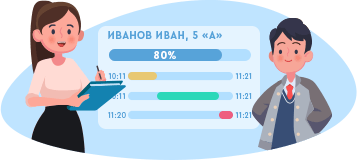— Hello, boys and girls!
— Welcome to our lesson!
— Today we have a guest.
— It’s our friend Brandon.

— Hello, everyone. I’m glad to see you!
— Hello, Brandon. We are glad to see you too!
— Guys, I’m here today, because I need your help.
— Oh, okay. What kind of help do you need?
— Well… I know nothing about the Past Simple Tense. And I don’t know when to use this tense.
— Oh, Brandon, don’t worry. We will explain this rule to you!
— Oh, thank you so much!
— No problem, Brandon!
— All right, boys and girls! Let’s start!
So, today in the lesson we will:
● talk about the Past Simple Tense;
● discuss when this tense can be used;
● learn how to form sentences in the Past Simple Tense;
And
● put the knowledge into practice.
The Past Simple Tense
Прошедшее простое время
Now let’s answer the question:
When do we use the Past Simple Tense?
We use Past Simple to describe actions, which happened in the past. They are completed.
For example:
Mrs. Johnson watered all the flowers yesterday.
This tense is used to talk about a series of completed actions in the past.
For instance:
First, Veronica got up, then she brushed her teeth.
Now, Brandon, let’s answer the following question:
How do we form sentences in the Past Simple Tense?
To form positive sentences we put the subject in the first place. Then we use the verb with the ending -ed if the verb is regular. And we use the second form of the verb if it’s irregular.
— Guys, sorry for interrupting you, but I’ve got a question.
— It’s okay, Brandon! What’s the question?
— What does “the second form of the verb” mean?
— Oh, it’s easy! There is a table of irregular verbs in English.
— Let’s take a look at a small fragment of this table.
— Oh, okay.
When we say “the second form of the verb”, it means that we have to find the verb in the table of irregular verbs and look at its form in the second column.
For example:
The second form of the verb “find” is “found”.
The second form of the verb “get” is “got”.
The second form of “have” is “had” and so on.
— Guys, thank you so much! Now I know what “the second form of the verb” means.
— Great! We are happy to hear that.
— Now let’s look at the examples of positive sentences.
— Okay.
Rick and Tom played computer games yesterday.
Or
My brother Nicholas read an interesting book last Friday.
To form negative sentences we put the subject in the first place. Then we use the auxiliary verb “did” with the particle “not”. The short form is “didn’t”. After that we put the base form of the verb.
Look at the examples:
Ryan and Blake didn’t watch the film yesterday.
Or
The boy didn’t catch any fish two days ago.
To form questions we put the auxiliary verb “did” in the first place. Then we put the subject. After that we need to use the base form of the verb.
Look at the examples:
Did Grace play the guitar last Monday?
Or
Did James ride a bike two days ago?
To give short answers to the questions we can use one of the following two constructions:
The first construction is…
In the first place we put the word “yes”. Then we use the personal pronoun. After that we need to put the auxiliary verb “did”.
And the second construction is…
In the first place we put the word “no”. Then we use the personal pronoun. After that we need to put the auxiliary verb “did” with the particle “not”.
Brandon, as we’ve already said, the regular past simple forms are formed by adding the ending -ed to the verb.
But there are some spelling rules, which you also need to know:
When the verb ends with the letter “e”, we need to add the ending -d to it.
For example:
Live – lived
Smile – smiled
Hate – hated
Move – moved
When the verb ends with a consonant and the letter “y”, we need to change “y” to the letter “i” and then add the ending -ed.
For instance:
Carry – carried
Study – studied
Try – tried
Marry – married
When the verb ends with a vowel and the letter “y”, we just need to add the ending -ed.
For example:
Play – played
Enjoy – enjoyed
Destroy – destroyed
Stay – stayed
When the verb ends with one vowel and one consonant, we need to double the consonant and add the ending -ed.
For instance:
Stop – stopped
Hug – hugged
Chat – chatted
Plan – planned
Now let’s answer the last question:
What time markers do we use in the Past Simple Tense?
In the Past Simple Tense we use the following time markers:
Yesterday
The day before yesterday
Last night/week/month/year etc.
Two days/weeks/years ago
— Brandon, we’ve talked about the Past Simple Tense.
— Yes, that’s right!
— Now we would like to check your knowledge if you don’t mind.
— Oh, okay!
Write the Past Simple form of the verbs!
And the verbs are:
Play
Watch
Find
Smile
Forgive
Stop
Try
Stay
Have
Plan
Give
Freeze
Move
Study
Enjoy
Go
Check yourselves!
The right answers are:
Played
Watched
Found
Smiled
Forgave
Stopped
Tried
Stayed
Had
Planned
Gave
Froze
Moved
Studied
Enjoyed
Went
Now…
Put the words in the correct order to make sentences!
Let’s check!
The right answers are:
Mr. Green went to bed late last Sunday.
Did Emily and Kate go jogging last morning?
Did you wash up the dishes after dinner?
Christopher did not fly to Dublin last year.
The kids woke up early last Saturday.
Molly did not leave the window open last night.
Did Chris read a whole book yesterday?
Anne did not play tennis two days ago.
— Well done, Brandon! Now you know everything about the Past Simple Tense.
— Yes, it’s true! Thank you so much, guys!
— It’s our pleasure, Brandon!
— All right! Now it’s time to say goodbye to everyone.
— Goodbye, friends!
— Goodbye, boys and girls!
— Goodbye!

 Получите свидетельство
Получите свидетельство Вход
Вход





 515
515

